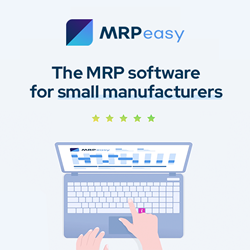Teach Students and Employees Automation With Fastems Digital Manufacturing Solutions – Virtually – No Equipment Required
[West Chester, OH - February 2020] Fastems has launched three new products to enable educational institutions and manufacturing enterprises to benefit from its advanced Digital Manufacturing (DM) solutions for factory automation. In addition to functioning as a classroom teaching and learning tool, DM enables companies to do training and testing before ramp-up and simulation during production, for example.
Thanks to Fastems' Digital Manufacturing solutions, no physical automation system is needed to simulate, educate, or introduce a factory automation system to clients, students, or employees. DM offers a cost-effective way to demonstrate and educate new factory automation technology. Fastems is a forerunner in this kind of solution offering in the field of automation for metal cutting.
"Our new solution enables teaching the theory of flexible manufacturing systems, demonstrating flexibility in manufacturing and the different flexible automation systems, and making classroom sessions more tangible through realistic visualizations," said Fastems Product Manager Janne Kivinen. "In addition to the benefits for educational institutes, DM brings great financial and productivity benefits to our industrial clients, making it possible to simulate the system effectively before hardware installation."
For instance, a customer may want preparations to be done before the system is delivered, which saves time during ramp-up. Software and layout verification can be done in advance, and detailed simulation and visualization capabilities allow testing options before committing to a certain layout configuration. Employees can be trained in a safe and interactive environment so that training doesn't disturb ongoing production. Further Fastems is developing new, innovative features to simulate and analyze alternative production scenarios to make smarter process decisions based on the results.
The new DM offering consists of three options: Virtual MMS (Manufacturing Management Software), Virtual FMS (Flexible Manufacturing System) and Virtual AMC (Agile Manufacturing Cell). Each of these solutions includes access to the software and 24/7 customer support. The Virtual FMS and AMC options include a Visual Components model, a 3D simulation software for manufacturing applications, including layout planning, production simulation, offline programming, and PLC verification, which functions as the manufacturing hardware of the system. All three products can be used as a local installation, and Virtual MMS can also be used as a cloud-based installation.
"Fastems DM is an excellent addition to classroom teaching. This solution allows us the opportunity to provide our students with a supreme learning experience in a classic classroom setting. We have received highly positive feedback on the courses, and we are able to constantly develop and improve our educational capabilities with the help of this system," said University Instructor Hasse Nylund and Professor Minna Lanz of Tampere University, Finland.
"Fastems Digital Manufacturing products provide a concrete way to bring manufacturing into the virtual world," said Janne Kivinen. "Better visualization capabilities allow our customers to understand the underlying concepts of our solutions and systems and to use their systems more efficiently. For educational purposes, a hands-on experience is extremely valuable and hard to achieve for such large and complex systems, so bringing them virtually into the classroom is a great alternative."
The DM concept is the first step towards developing a true Digital Twin for Fastems automation solutions, which will translate into better maintenance and production efficiency to the users of the system. In the future, Digital Twins will allow following the system, its parameters, and everything it interacts with for the entire lifecycle of the system, enabling better tools for production optimization, maintenance and intelligent manufacturing.
About Fastems
Founded in 1901, Fastems delivers intelligent factory automation solutions that help metalworking manufacturers to increase their productivity. Their provisions include consulting services in the field of material handling up to flexible manufacturing systems, robot-based automation solutions, software for production control, portal and gantry systems as well as a comprehensive range of services. The capacity usage of machine tools can be increased with these solutions, and the processes can be optimized. With the help of the intelligent software MMS production and tool management are efficiently planned, forecasted, controlled, visualized and monitored. Due to the openness to different systems and interfaces, the opportunities offered by new technologies, digitalization and integration are consistently implemented in customer-oriented software and hardware solutions. Fastems has its headquarters in Tampere (Finland). With manufacturing facilities in Finland and Germany as well as a global sales and service organization, the company employs approximately 450 people.
Featured Product

MRPeasy - ERP for Small Manufacturers That Delivers Results
Always know what you have in stock and what you'll need to fulfill orders. Never forget to order parts on time or fail to notice a late delivery from your vendor. Easily create manufacturing orders and schedule them automatically according to resource availability or delivery deadline. Generate accurate cost and lead time estimates and provide customers with quick quotes. Receive notifications when orders are late or inventory levels reach a critical point. Ensure seamless communication between sales, production, warehousing, procurement, administration, and finance. Integrate with popular accounting, CRM, and e-commerce apps. MRPeasy is an ERP software for small manufacturers that gives you all that and more. Our users report a 54% average improvement in the overall performance of their business and a 42% increase in on-time deliveries. Try for free, no credit card needed.
